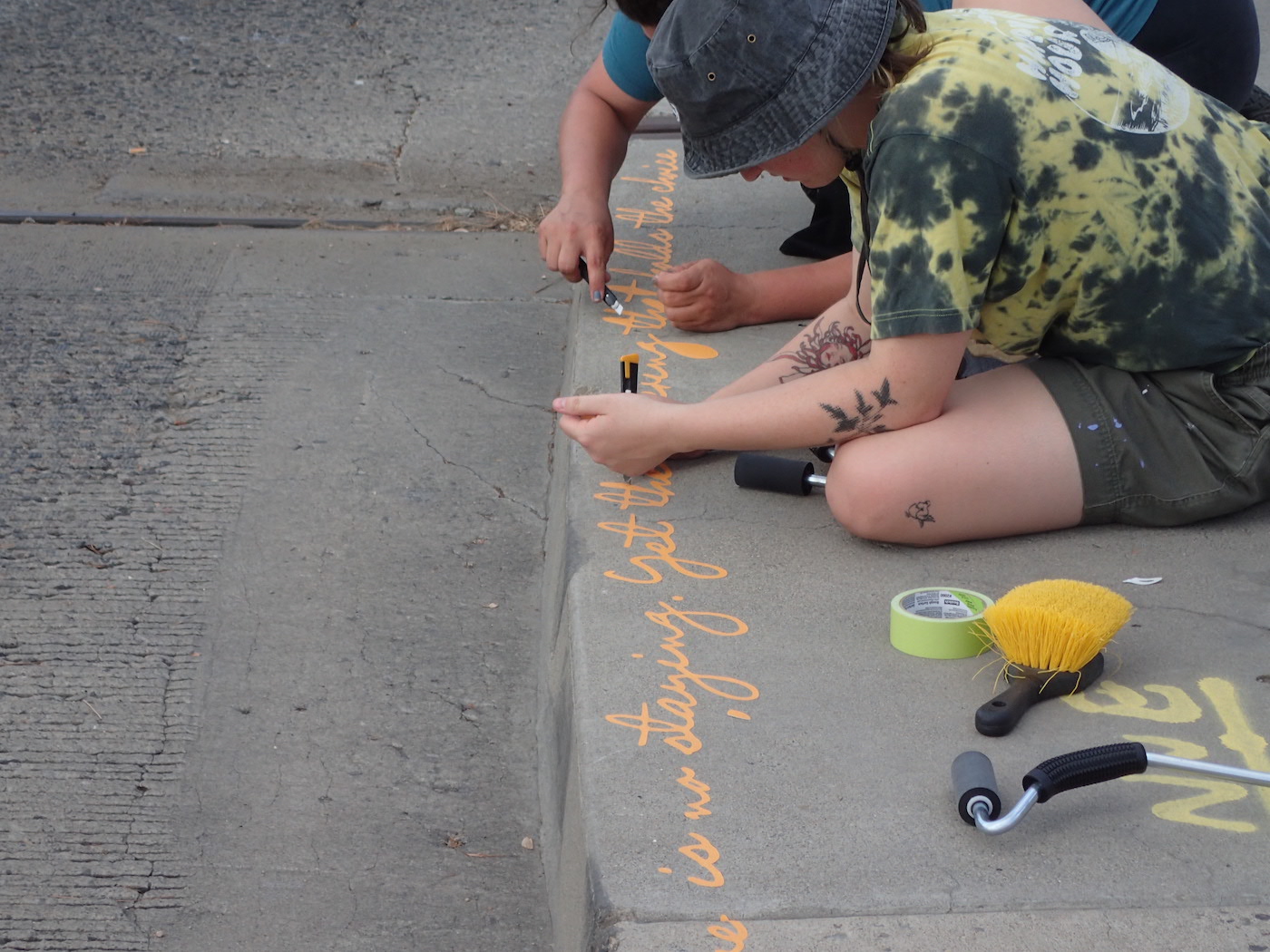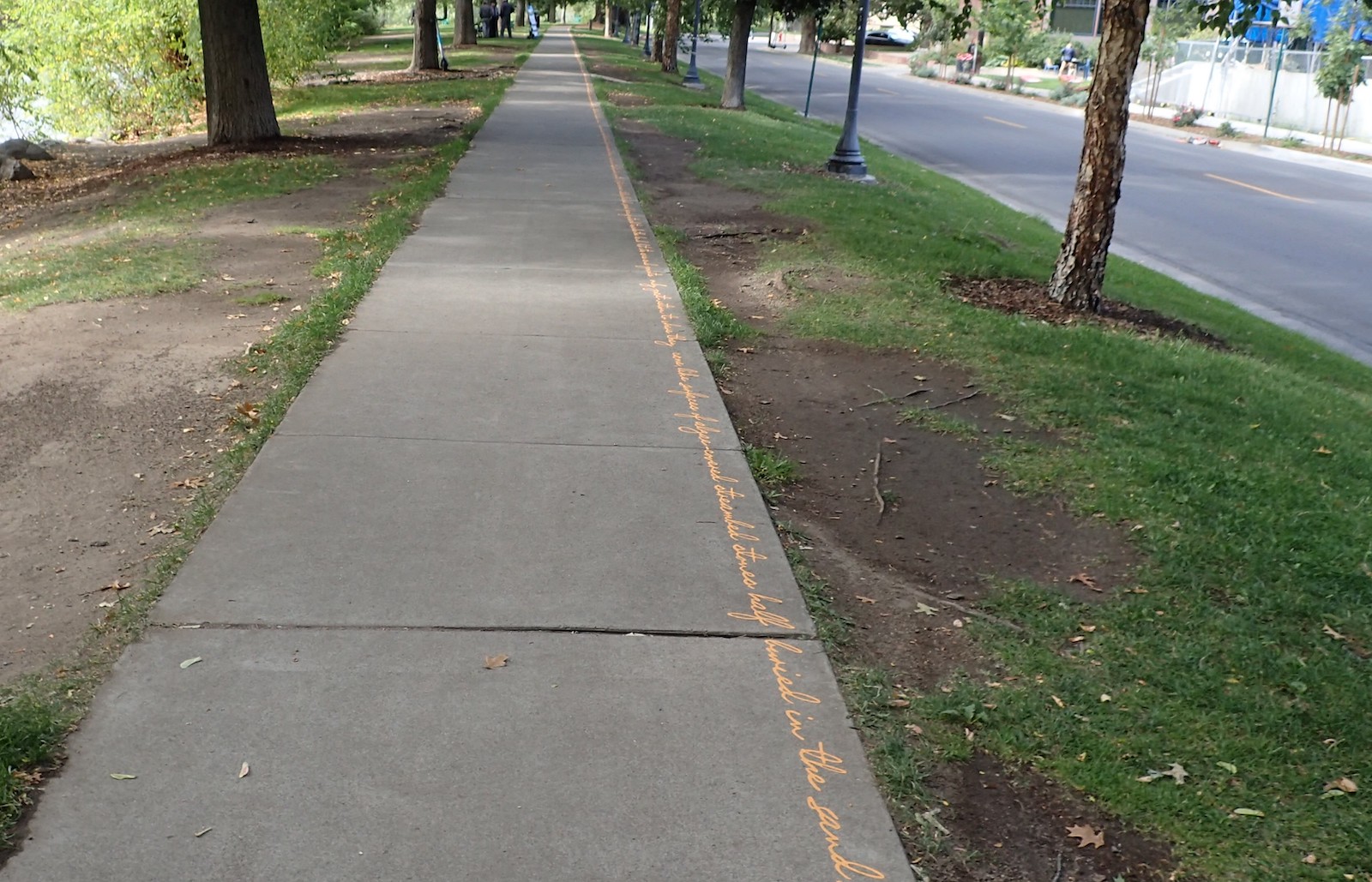Art Meets Ecology In A Mile-Long Poem
5:12 minutes


One year ago this month, we launched our podcast Universe Of Art, which features arts-focused science stories, like the science behind “Dune” and why a group of science illustrators created an online celebration of invertebrate butts. And to our surprise, a lot of you wrote in to tell us about your own science-inspired art projects, including artist Todd Gilens.
Gilens is a visual artist and designer who collaborated with the city of Reno, Nevada, to create a mile-long poem, called “Confluence,” printed on the city’s sidewalks bordering the Truckee River. He was interested in how water shapes landscapes, and how urban architecture can mirror those natural processes. He later found the Sierra Nevada Aquatic Research Laboratory, a University of California field station near Mammoth Lakes, and spent several field seasons with them to learn about stream ecology.
Universe Of Art host D. Peterschmidt sat down with Todd to talk about how the poem came together and why he spent four field seasons in the Sierra Nevada with stream ecologists to create the piece.
Invest in quality science journalism by making a donation to Science Friday.
Todd Gilens is a visual artist and designer based in Berkeley, California.
ARIELLE DUHAIME-ROSS: One year ago, we launched our podcast, Universe of Art, which features stories at the intersection of art and science. And to our surprise, a lot of you wrote in to tell us about your own science-inspired art projects that you’re making in your spare time. For this week and the next, we’re going to feature some of these listeners for Universe of Art’s one-year birthday. D. Peterschmidt, who hosts the show, talked to one of these artists who embedded with scientists in the field for many seasons to make his work come to life.
TODD GILENS: My name is Todd Gilens, and I’m a visual artist. I do mainly temporary public projects. People encounter the work not actually knowing why it’s there or that it’s artwork. They just see something that’s a little different than what they expected.
D. PETERSCHMIDT: But when Todd started working on this one project, which took nine years to produce, he knew the only way he could finish it was by diving into the science.
TODD GILENS: I really wanted to understand, not just at a superficial level, what water does in the landscape.
D. PETERSCHMIDT: Todd worked with the city of Reno, Nevada, to create a mile-long poem printed on its sidewalks that border the Truckee River, which is fed by the melting snowpack from the nearby Sierras. He’d been thinking about sidewalks and how they’re like streams in the mountains. Both of them are narrow channels that direct the flow of water or people, with life flourishing along the way.
And for him, poetry was a way to immerse a passerby in a stream of words, letting the flow of the poem carry them through the city’s connections to the nearby mountains, like a leaf caught in the flow of a river. But he didn’t exactly know how these stream channels change the landscape.
TODD GILENS: I wanted to understand this process and what was actually going on there so that, when someone’s reading a piece of the poem, they can imagine what had been there in that very spot before urbanization and also what is still going on in the mountains just adjacent to the city.
D. PETERSCHMIDT: Here’s a part of that poem, called “Confluence.”
TODD GILENS: Lightly, on a slope of stone, a trickle sounds. And some small, flying insects sip and celebrate the drop of temperature, moisture, puffs of moss in hand-sized pools, enough, as cracks conduct through centuries of snow from reservoirs within the mountain rock.
D. PETERSCHMIDT: Todd needed to do some research, but he is not the kind of person who just phoned that in.
TODD GILENS: And I specifically wanted a scientific approach. I could have read the literature on mountain streams. I really did not know what I was getting into. I was really very innocent. But it wound up that I spent four years– four field seasons surveying streams with a couple of different teams of scientists.
D. PETERSCHMIDT: Todd just started showing up at field stations run by the University of California in the Sierras. He talked to whoever was there and pitched himself as an artist working on a public poem, but also as a researcher with his own scientific questions.
TODD GILENS: And they were really welcoming. They had work to do, but they were also really pleased to share what they were doing.
D. PETERSCHMIDT: He got in contact with a couple other groups and basically became another member of these teams, helping them carry equipment on three-hour hikes into the mountains, banding frogs in Yosemite. And eventually, he found a team that was experimenting with constructing concrete stream channels in the Sierras.
TODD GILENS: They were as fascinated with what I was doing as I was with what they were doing. But I was really there– like, I was a double agent.
D. PETERSCHMIDT: [LAUGHS]
TODD GILENS: I was supporting them in their science. And they were like, hmm, I wonder what Todd’s going to come up with. And whenever I had a question, I could say, hey, what about this? And they could show me through the microscope what was going on. And then I could reflect that in words and images.
The slopes chime gently as a liquid Earth flows by beneath the dry. But here and there, the arid and the wet will cross, revealing that which we call moisture, spring, brook, river, flow. Another chance to name and know what surfaces can hide or clarify and what goes on below.
D. PETERSCHMIDT: After writing the poem, Todd created a custom font that was printed in bright yellow on contact paper, kind of like a bumper sticker, into 9-foot long strips about 6 inches high. It took him and a handful of art school graduates about three weeks to install it on over 6,000 feet of Reno’s curbs.
TODD GILENS: Somebody commented that they came across the piece, and they started reading, and before they knew it, they were three blocks out of their way. So that was really what I hoped for was that the work would engage someone in the physical act of walking, of being in the city, and at the same time, engage their imagination in the regional environment and the dynamics of how water shapes landscapes.
D. PETERSCHMIDT: “Confluence” will be on Reno’s sidewalks until September, and you can check out photos of it on our website. That’s at sciencefriday.com/sidewalkpoem. I’m D. Peterschmidt.
Copyright © 2024 Science Friday Initiative. All rights reserved. Science Friday transcripts are produced on a tight deadline by 3Play Media. Fidelity to the original aired/published audio or video file might vary, and text might be updated or amended in the future. For the authoritative record of Science Friday’s programming, please visit the original aired/published recording. For terms of use and more information, visit our policies pages at http://www.sciencefriday.com/about/policies/
Dee Peterschmidt is a producer, host of the podcast Universe of Art, and composes music for Science Friday’s podcasts. Their D&D character is a clumsy bard named Chip Chap Chopman.
Arielle Duhaime-Ross is freelance science journalist, artist, podcast, and TV host based in Portland, OR.